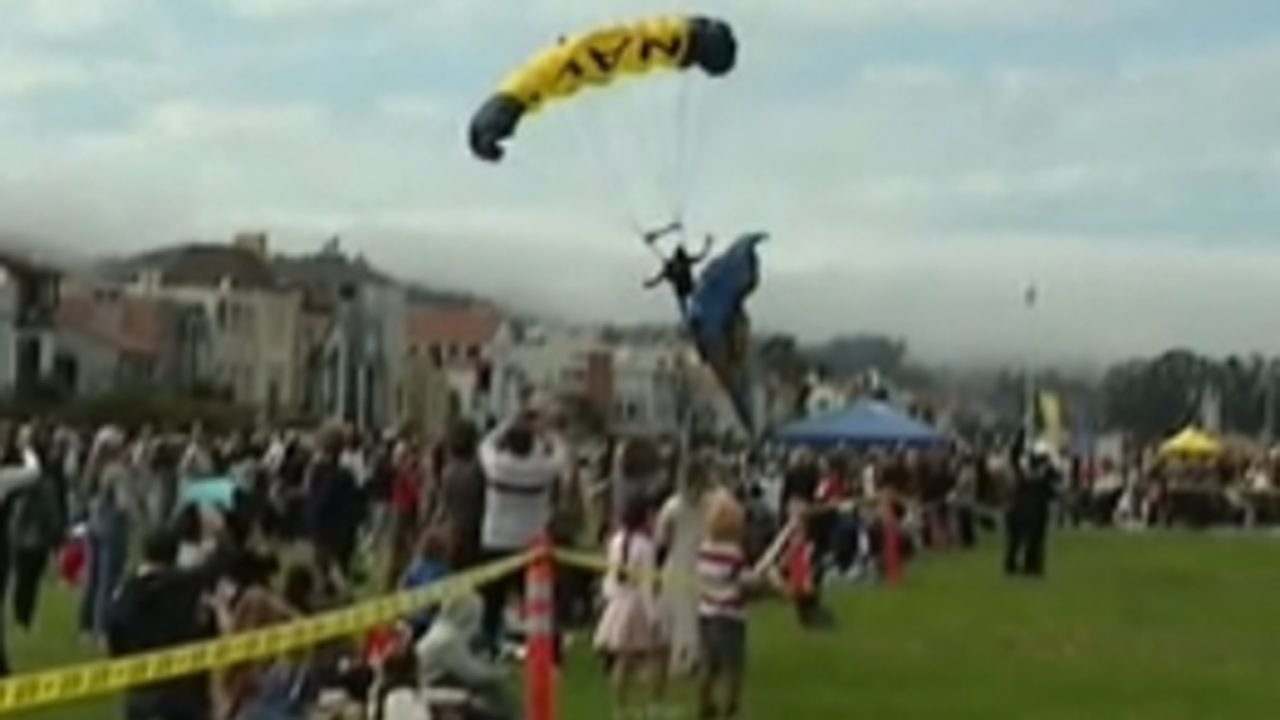The thrill of a Navy Leap Frogs parachute demonstration during San Francisco’s Fleet Week took a dramatic turn when a parachutist miscalculated his landing, colliding with a mother and her teenage child. This unexpected incident, captured on video and widely circulated, raises critical questions about safety protocols and the inherent risks associated with such high-profile performances. While the individuals involved sustained only minor injuries, the event serves as a stark reminder of the potential for unforeseen circumstances even in meticulously planned displays of skill and precision. This incident highlights the need for rigorous safety reviews and a renewed focus on mitigating risks in these types of public performances. The Navy’s immediate response acknowledging the incident and initiating a thorough review process is a commendable first step, though a comprehensive examination of procedures and potential improvements is warranted to prevent similar occurrences in the future.
The San Francisco Fleet Week Parachute Accident
The accident unfolded during a seemingly routine performance by the Navy Leap Frogs parachute team, a highly skilled group known for their precision jumps and aerial displays. One of the six parachutists, carrying a large banner, deviated from his intended landing zone, making a forceful impact into a crowd of spectators. A mother and her teenager were directly struck by the parachutist, sustaining minor injuries. While both were treated at the scene, the mother required further evaluation at a local hospital. The parachutist, fortunately, escaped the incident without any injuries. Videos of the incident quickly spread across various social media platforms, garnering significant public attention. Initial reports highlighted the chaotic scene following the collision, with onlookers rushing to help those who had been injured.
Eyewitness Accounts and Video Footage
Several eyewitness accounts described the incident as unexpected and jarring. Many present at the event expressed shock and concern over the parachutist’s apparent miscalculation, as the Leap Frogs are known for their precision and years of extensive training. Video footage of the event circulated rapidly online, illustrating the impact’s force and the ensuing commotion. These eyewitness reports and video evidence have played a vital role in investigations and subsequent safety reviews being undertaken by naval authorities. This visual record offers investigators valuable insights into the sequence of events leading up to the crash, assisting them in determining potential contributing factors.
Investigating the Cause and Implementing Safety Measures
Following the accident, the Navy issued a statement expressing concern for those injured and initiating a comprehensive internal investigation. The statement emphasized the Navy’s unwavering commitment to safety as their paramount priority. This review will undoubtedly cover multiple facets of the incident, examining various factors, including weather conditions, equipment malfunctions, and the parachutist’s skill and decision-making process leading up to the landing. The process might entail review of pre-jump briefing protocols, contingency planning for unexpected occurrences, and assessment of risk mitigation procedures employed by the team during training and performances.
The Role of Training and Protocols
The investigation will delve deeply into the rigorous training undergone by the Leap Frogs, a team composed of elite Navy SEALs and other highly specialized personnel. The existing training regimen and protocols will be reviewed meticulously, searching for areas for improvement or the identification of shortcomings that might have contributed to the accident. This review is likely to scrutinize the quality of training, evaluating procedures for handling unexpected winds, navigational errors, or potential equipment issues that might negatively affect a landing. The investigation will not only aim to find root causes but also look at proactive safety enhancement options in the future. Modifications to landing zone selection, risk assessments and communication procedures may also be considered.
The Navy Leap Frogs: A Renowned Parachute Team
The Navy Leap Frogs are renowned for their exceptional skills and daring demonstrations. Their performances are characterized by challenging maneuvers and synchronized jumps. Comprising members from various elite Navy special operations units, these individuals undergo extensive and rigorous training. This high-caliber training encompasses all aspects of airborne operations, encompassing specialized parachute techniques, freefall practices, and coordinated formations in midair. This background is why this incident has sparked significant concern, as the team’s track record for flawless performances has preceded this unusual occurrence. The incident brings into sharp focus the unexpected risks inherent in such visually spectacular high-stakes public performances, even when executed by highly skilled personnel.
Public Perception and Future Performances
The accident, even with minor injuries to the public, may influence public perception of Navy Leap Frog demonstrations. The team, having traditionally generated positive responses with its performance quality, may need to adjust its approach following this high-profile incident. Future performances might involve revised safety protocols and, potentially, changes in routines or demonstration types. Maintaining public confidence is paramount, and a reassessment of existing safety procedures might restore the team’s pristine reputation, showing that lessons have been learned from this singular mishap.
Takeaway Points
- The San Francisco Fleet Week parachute accident highlighted the potential risks even in highly skilled and well-rehearsed public performances.
- The Navy’s swift response, acknowledging the incident and initiating an investigation, emphasizes their commitment to safety.
- A thorough investigation will critically evaluate training procedures, equipment, and contingency plans.
- This incident serves as a reminder that safety reviews and protocols should continually be revisited and improved, even for highly skilled personnel. It will likely lead to better safety protocols for similar future events.









